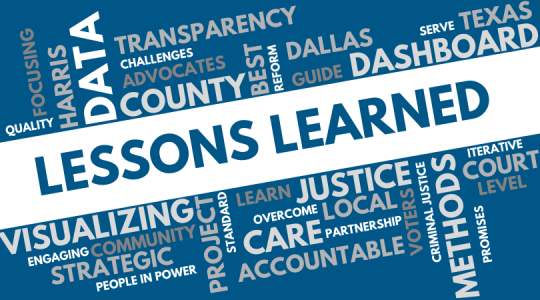
Over the last two years, the Texas Criminal Justice Coalition has worked to make the state’s criminal justice system more transparent by obtaining and visualizing criminal court data. Beginning with Harris County, this project has helped hold people in power accountable for their promises of reform.
With funding from Microsoft Cities Team and a partnership with data science firm January Advisors, this work expanded geographically to Dallas County, as well as expanding in scope to encompass best practices for increasing transparency in local criminal justice systems throughout Texas.
This is an iterative process. Criminal court disposition data is controlled at the county level, and Texas has 254 counties. Our approach was to begin by focusing on two of Texas’ most populous counties where reforms are already taking place. But it wasn’t easy.
Along the way, we encountered challenges related to obtaining and cleaning data, ensuring quality data, and visualizing data in ways that help people understand the narratives behind the data. Among other lessons, we learned the following while attempting to overcome these challenges:
- The data must serve different kinds of community members, including advocates, voters, researchers, policymakers, and more. Engaging with each group helps shed light on what they want to get out of the experience.
- Data is not standardized across Texas counties, so we had to develop methods for collecting, managing, and visualizing disparate datasets. Spelling mistakes are common!
- Projects like this require a strategic data infrastructure, because even data from two counties requires a lot of care to maintain and update.
For more on each of the lessons learned, click here for a guide on our experiences.
In addition to the lessons we learned, this guide outlines the steps we took, and the hurdles we faced, while working on this project. It also includes ways that the data could be used beyond the dashboard, such as tracking the impact of diversion programs and other campaign promises by elected officials. Finally, the guide outlines best practices for how to obtain new datasets and bring greater transparency to the other 250+ counties in Texas (and beyond!).
We hope you enjoy learning about our experience as much as we enjoyed working on the project. And stay tuned for more to come!